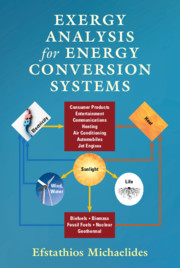Book contents
- Exergy Analysis for Energy Conversion Systems
- Exergy Analysis for Energy Conversion Systems
- Copyright page
- Dedication
- Contents
- About the Author
- Preface
- Symbols
- Abbreviations
- 1 Introduction
- 2 Exergy
- 3 Energy Conversion Systems and Processes
- 4 Exergy Consumption and Conservation
- 5 Exergy in Biological Systems
- 6 Ecosystems, the Environment, and Sustainability
- 7 Optimization and Exergoeconomics
- Index
- References
3 - Energy Conversion Systems and Processes
Published online by Cambridge University Press: 19 March 2021
- Exergy Analysis for Energy Conversion Systems
- Exergy Analysis for Energy Conversion Systems
- Copyright page
- Dedication
- Contents
- About the Author
- Preface
- Symbols
- Abbreviations
- 1 Introduction
- 2 Exergy
- 3 Energy Conversion Systems and Processes
- 4 Exergy Consumption and Conservation
- 5 Exergy in Biological Systems
- 6 Ecosystems, the Environment, and Sustainability
- 7 Optimization and Exergoeconomics
- Index
- References
Summary
The application of the exergy methodology reveals the system components where high exergy dissipation occurs and improvements may be accomplished to conserve energy resources. The method is applied to several systems: heat exchangers, including boilers and condensers; vapor and gas power cycles, including cogeneration units; jet engines; and geothermal units. Calculations on exergy dissipation identify the processes and components where improvements would save energy resources. The calculations reveal that combustion processes waste a great deal of exergy, leading to the conclusion that direct energy conversion devices, such as fuel cells, utilize fossil fuels in a sustainable way. The exergy method is also applied to photovoltaic cells and thermal solar power plants, as well as to solar collectors that deliver heat. Significant exergy destruction occurs in wind turbines because of Betz’s limit and the wind turbine characteristics. A large number of examples in this chapter elucidate the exergy calculations and provide guidance and resources for the application of the exergy methodology to power and heat generation systems and processes.
Keywords
- Type
- Chapter
- Information
- Exergy Analysis for Energy Conversion Systems , pp. 79 - 146Publisher: Cambridge University PressPrint publication year: 2021



